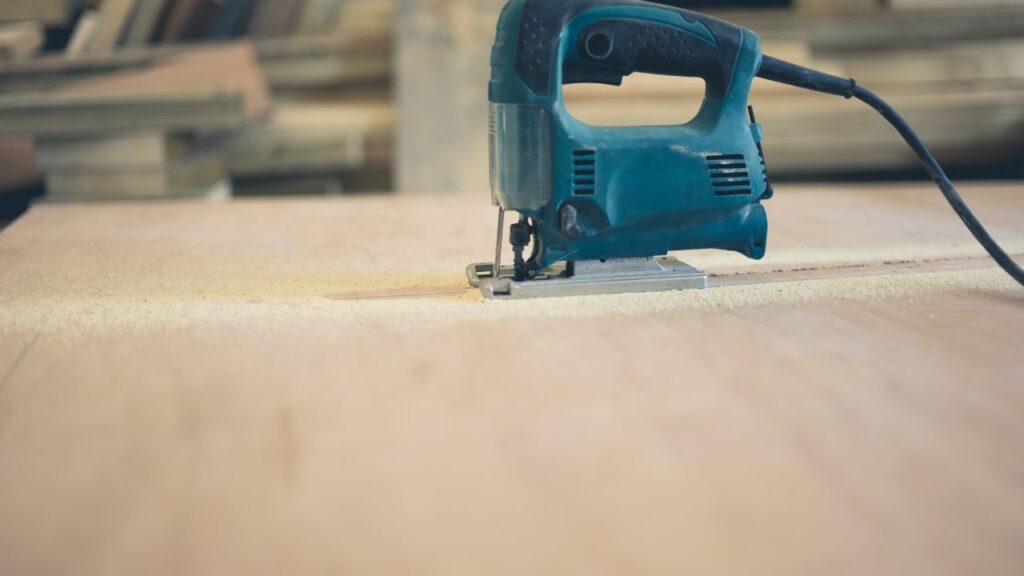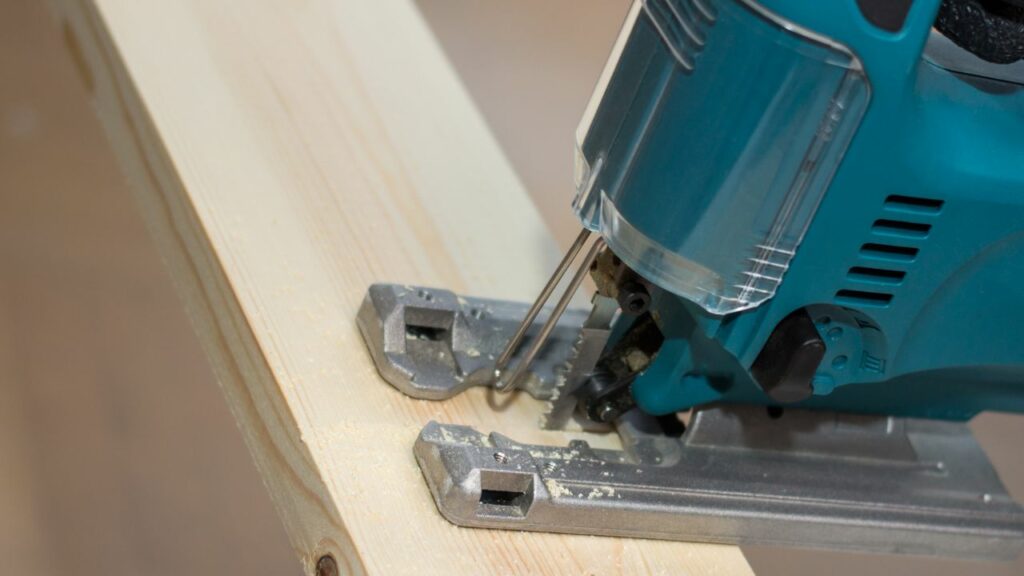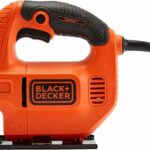Last Updated on November 27, 2023 by Pro Handyman Australia – Editorial Team
A jigsaw is a versatile power tool primarily designed for making intricate cuts, especially nonlinear shapes and curves. If you’re wondering how to use a jigsaw effectively, it’s important to note that with a thin blade and adjustable cutting speed, it provides craftsmen the flexibility to craft precise designs. Though capable of straight cuts, its true strength lies in detailing. Understanding its capabilities and functions will help you maximize its potential in your projects.
Understanding a Jigsaw
The jigsaw stands out among other power tools for its unique ability to craft intricate shapes and curves. Unlike tools specifically crafted for straight cuts, a jigsaw’s slender blade, controlled by a throttle trigger, is best suited for more detailed work. This design provides users the freedom to adjust the cutting speed as per their project needs.

Blade Limitations and Proper Usage
While a jigsaw’s blade is designed for precision, its size and thinness come with their own challenges. The blade can bend or break if mishandled. Knowing about different jigsaw blade types can help users select the right one for specific tasks, ensuring smoother cuts and reduced chances of mishaps. Additionally, the tool’s vibratory motion, effective for cutting, can be a challenge for beginners. It’s essential to apply gentle forward pressure during use, ensuring the blade has adequate time for optimal cutting
Versatility in Material Cutting
Beyond wood, the jigsaw’s capabilities expand to various other materials, highlighting a versatility different from the more specific table saw uses. By simply changing the blade, users can effortlessly cut through steel, fiberglass, and even drywall. This adaptability amplifies its worth in any workshop, complementing the functions of a table saw.
Easy Blade Replacement
Changing the blade is a hassle-free process. One should start by disconnecting the saw from the power source. Then, by rotating the dial connecting the blade counter-clockwise, the blade is released, allowing for the placement of a new one. Once secured, the dial locks the blade in place.
Types of Cuts with Jigsaws
Mastering Curves
Among portable power tools, jigsaws hold a unique position for their capability to cut curves expertly. This feature is especially invaluable to woodworkers, as it offers a faster and more efficient alternative to the traditional hand-held coping saw.
Jigsaws distinguish themselves with their delicacy, setting them apart from other power saws. Their slender blades are adept at navigating tight spaces, making it simple to follow curved patterns. Their lightweight nature complements this feature, as it provides ease in maneuvering and tracing over stenciled designs. Furthermore, when it comes to crafting circles, jigsaws are unparalleled in precision. Whether you’re working freehand or with the assistance of a circle cutting guide, you can achieve circles of almost any dimension with remarkable accuracy.
Mastering Straight Cuts
Jigsaws aren’t restricted to just curves. By fitting them with a marginally broader blade, you can also achieve precise straight cuts. These straight cuts can be executed either along the grain or across it when working with wood. Beyond wood, jigsaws are also adept at cutting other materials, such as laminates. Simply guide the tool along a straight edge, and you’re good to go.

Perfecting Plunge Cuts
The jigsaw boasts a unique ability: executing plunge cuts. A plunge cut is initiated from the center of a material, bypassing the need to start from the edge. This technique is invaluable for tasks like creating openings in wood or plasterboard for fixtures like electrical outlets or mail slots. One of its most prevalent uses, however, is carving out a sink space in a fresh kitchen countertop.
Precision with Bevel Cuts
Contrary to popular belief, creating bevel cuts doesn’t require a high-end adjustable table saw. Most jigsaws come equipped to angle up to 45 degrees, perfect for bevel cuts. The adjustment is typically managed by a lever located above the saw’s shoe, which when unlocked, allows the saw to tilt.
The versatility of a jigsaw extends to bevel cuts as well. Most jigsaws come equipped with a pivoting shoe, which facilitates angled cuts in moldings and boards. This shoe can be adjusted to angles as steep as 45 degrees, allowing the jigsaw to produce a beveled edge with precision.
User Experience and Safety
The Advantages of Going Cordless
Modern advancements have ushered in a new era of jigsaws—cordless ones. Without the restriction of a cord, users can maneuver the tool more freely, ensuring intricate and elaborate curves. Newer models, especially those powered by batteries, are designed to be lightweight and streamlined, making them even more user-friendly.
Child-Friendly Operation
Jigsaws are unique in their child-friendly design. When given appropriate instruction and with diligent adult supervision, children can handle them safely. The tool’s inherent design, where it rests on the material’s surface during operation, ensures that it doesn’t necessitate significant strength to maintain stability. This design also facilitates keeping hands and fingers away from the blade, making jigsaws an excellent initial power tool to acquaint children with.
User-Friendly for All

The simplicity of jigsaws extends beyond their application with children. Regardless of whether you’re a novice or a seasoned craftsman, the tool’s design ensures a hassle-free experience. Setting it up is a breeze: simply attach the blade, connect the power source—be it plugging it into an outlet or inserting a battery for cordless variants—and you’re all set. Furthermore, their compact nature ensures they fit comfortably in any workshop, irrespective of its size, without hogging shelf space.
User Experience with Jigsaws: Real-Life Testimonials
It’s one thing to know the technical details and features of a jigsaw, but it’s entirely another to understand how it performs in the hands of everyday users. Here, we dive into hands-on experiences and reviews from real-life users to give you a sense of what to expect:

Jeremy, a DIY enthusiast, shares his experience:
“I recently got the BLACK+DECKER 400W Jigsaw, and it’s been a game changer for my woodworking projects. It glides smoothly, and the precision is impeccable. The variable speed settings make it versatile for different materials too.”

Melissa, a professional carpenter, states:
“I’ve been in the trade for over a decade, and the Bosch 530W Electric Jigsaw is by far the best I’ve used. It’s not just about the power; it’s about the ergonomics, the blade stability, and the efficiency. Highly recommended for both professionals and hobbyists.”
From these firsthand accounts, it’s evident that user experience varies based on the model and brand of the jigsaw. Real-life tests offer invaluable insights, which are often overlooked in standard product descriptions.
Jigsaw Comparisons: Top Models Analyzed
For those who are serious about their tools, a surface-level understanding isn’t enough. Here, we offer an in-depth comparison between two top jigsaw models: BLACK+DECKER 400W and Bosch 530W.
The Perfect Partner for Seasonal Crafts
Speaking of versatility, ever considered using a jigsaw for your Halloween crafts? Those looking to make a splash at their next pumpkin carving gathering might consider wielding a jigsaw. Not only does it expedite the process of cutting off pumpkin tops, but a skilled hand can also employ it to carve intricate Jack O’Lantern designs, making your creation the talk of the party.
| Feature | BLACK+DECKER 400W | Bosch 530W |
|---|---|---|
| Power (Watt) | 700 | 650 |
| Blade Speed (SPM) | 3000 | 3200 |
| Maximum Bevel Cut (°) | 45 | 47 |
| Weight (lbs) | 6.3 | 6.0 |
| Price ($) | 159.99 | 179.99 |
While the BLACK+DECKER 400W boasts a slightly higher power, the Bosch 530W edges it out in terms of blade speed. The decision, of course, depends on what specific features are more crucial for the user.
Conclusion
Jigsaws, with their unique combination of safety, simplicity, and versatility, cater to users across age groups and expertise levels. Whether you’re introducing a child to the world of craftsmanship or seeking to impress with your pumpkin carving skills, the jigsaw proves to be a trusty companion. Its applications extend beyond traditional woodworking, reiterating its place as a valuable tool in any craftsman’s arsenal.
